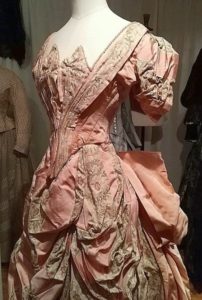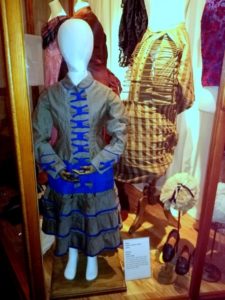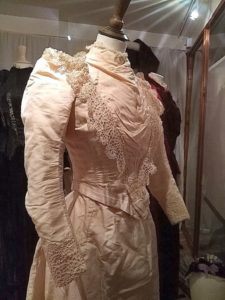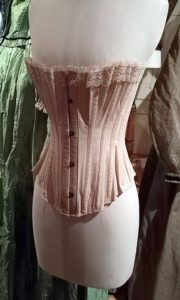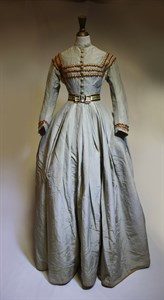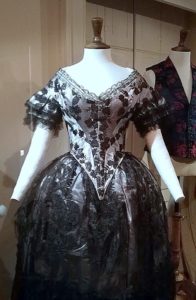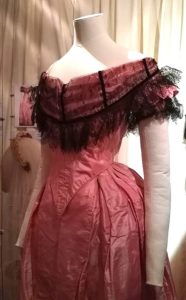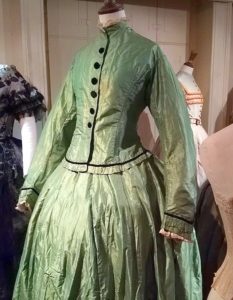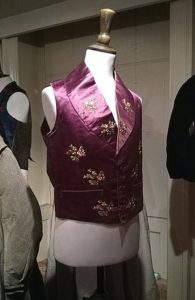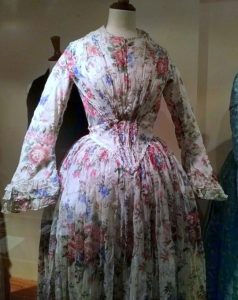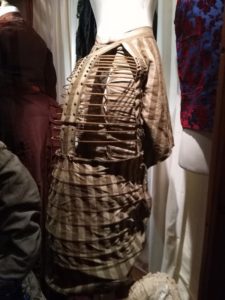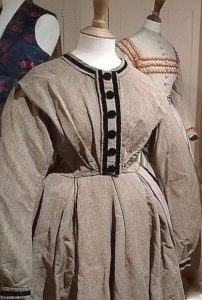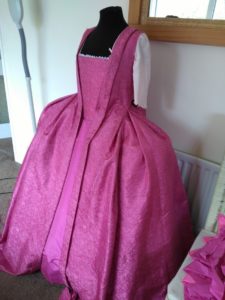Last Monday I visited Normanby Hall. Normanby Hall Country Park is a beautiful 300-acre estate set in the heart of North Lincolnshire. Open to the public every day of the year, the park offered a perfect backdrop to our day out.
Normanby Hall’s costume gallery features the exhibition ‘Victorian Vogue’ during the 2016 season. The exhibition takes items from the hall’s extensive costume collection to document changes in fashion from the 1840’s to 1890’s.
The costumes were on the first floor and although I must confess to be perfectly honest that the Victorian costumes are not my favourite period (as I find them quite fussy and over ornate) – it was a very good exhibition that included quite a number of very interesting items.
The costumes were dressed on mannequins with a number of accessories from the period also included. Three large glass cases of costumes were situated in the bigger room with another glass case in the much smaller room next door. The display was lit with a low yellow light so the costumes would not fade. I know from experience that a lot of fabrics particularly silk can fade in strong light however the costumes could still be easily seen. Because they were behind glass it made photographing them more difficult so some of my pictures aren’t as clear as I would like them to be – however they certainly needed to be protected. No flash photography was allowed – this may seem extreme but it has been proved that a large number of bright flashes can definitely fade clothes over time. Some of the dresses particularly a very delicate pink silk evening dress seemed quite fragile.
I can’t include every costume/accessory included in the exhibition but I have included some of my favourites to give you a favour of the exhibition –
Pink Evening Dress c 1885 – 1890
Corded silk evening dress with bustle and long train.The bustle comprises a pad at the back of the skirt with rows of steel bands below – It is fastened in position by tapes so that when the dress is in storage it can be laid flat. Very ornate and quite complex dress however very beautiful – I love the combination of silk and lace trimming and also the colour.
Girls Dress c 1877 – 1879
Cotton dress for a girl of around nine years of age.Girls dresses were similar in style to the fashionable dresses of their mothers, but shorter. This girl would not have worn a wire bustle but rather a small pad under her skirt at the back.
Wedding Dress c 1893 – 1895
Grosgrain wedding dress comprising bodice and skirt with train.The bodice is boned and is decorated with lace and satin ribbon. There are pearl beads around the neck. Ivory coloured wedding dresses were popular from the 1870’s. Many were altered for evening wear afterwards. A very elegant gown reminds me of the costumes worn in ‘Room with a View’ with Helena Bonham Carter.
Corset 1860’s
Twilled cotton corset with 22 bones. It has lace decoration at the bust and is shaped to allow it to fit closely over the top of the hips. This corset seems to have a very narrow waist circumference when laced. It certainly wouldn’t fit me a UK size 12-14 – I would hate to have to wear something so restrictive all day. I suppose however if you are brought up wearing corset them from a young age you may not notice so much or know anything different!
Wedding Dress c 1860’s
Shot taffeta wedding dress comprising of bodice, skirt and belt. The buttons are purely decorative as the bodice actually fastens with hooks and eyes.Wedding dresses were normally made in the current fashion for day dresses and worn with either a bonnet or a veil hanging behind the head. Brides of social standing wore white as did their bridesmaids, but many of the lower classes simply had a new best, coloured dress. Remind me of gowns worn by Joan Fontaine in the 1939 version of ‘Jane Eyre’.
Evening Dress c 1850’s
Grey satin dress covered in black Spanish bobbin lace. The skirt is lined in calico to stiffen its skirt and keep its shape.Lace was often used a s a status symbol because of the different grades of quality. It was often passed down as a family heirloom. Most lace was machine made by the Victorian period.The pointed waistline combined with the decorated sleeves gives an illusion of a slimmer waist. I am not so keen on the black lace but really like the slimming shape of the dress.
Evening Dress c 1874
Silk evening dress comprising bodice and skirt. The bodice is boned and is decorated with black lace and velvet.The skirt has two more bodices in the same material along with an unfinished skirt and other pieces of material. The skirt has started to be modified, with the front cut open and tacked back. I love the fabric,colour and neckline- not so keen on black lace personally I would prefer white if it was for me however a very pretty gown.
Dress 1850’s
Green silk dress with narrow black stripes. The dress has a separate bodice and skirt. There is a lace trim around the collar and ruffle around the waist and cuffs. The velvet covered buttons are purely decorative as the bodice fastens with hooks and eyes. The back of the bodice is tailored to rest on the large skirt. The bodice and particularly the skirt look a strange shape – perhaps it’s the hoop petticoat underneath at fault however I cannot tell what’s happening under the dress. Perhaps it just needs a few more petticoats or a different mannequin.
Waistcoat c 1860
Satin waistcoat with hand embroidered floral decoration. It is lined and backed in tough cotton.The hand embroidery is particularly beautiful.
Dress c 1844 – 1852
White muslin dress with floral pattern. The sleeves and the bodice are lined and many petticoats would have been worn under the skirt. The front of the bodice is boned.The long narrow shape of the waist was achieved by means of a long one-piece corset supported by shoulder straps and shaped at bust and hips. I love the shape of the bodice – it’s very well made and fits so well and the fabric is very fine and pretty.
Behind Bustle c 1870 – 1885
Bustle with 25 steel hoops, which are adjustable with a lace inside. The bustle was fastened around the waist with buttons underneath the dress to create the fashionable shape of the 1870’s. It is quite a complex structure which I think would fold down for storage. I think I certainly wouldn’t need a bustle as large as this with my figure!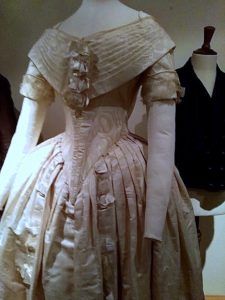
Wedding Dress c 1841 – 1850
Watered silk (Moire) wedding dress with satin ribbon decoration. The whole dress is lined in cotton and the bodice is boned. There is a large pocket inside the skirt at the back. This reminds me of the wedding dress worn in Jane Eyre – remember the scene where Rochester contrasts his ‘mad’ wife with Jane who is standing dressed in a beautiful virginal white dress for their wedding.
Dress c1863 – 1864
Twill-woven cotton winter dress with black velvet trimming on the bodice and cuffs. The vulcanite buttons are purely decorative as the bodice again fastens with hooks and eyes. There is a large pocket on the inside of the skirt at the front. Not particularly keen on this dress but it does show a different kind of day dress possibly worn by the lower classes.
It is great for a designer to actually see extant costumes up close and working out how they were made/decorated etc. There is nothing like seeing them ‘in the flesh’. I would certainly recommend this exhibition for lovers of history and costume!
http://www.normanbyhall.co.uk/whats-on/exhibitions/#.V2-lNrgrKUk
By the way last week I also visited a new exhibition at York Museum called ‘Shaping the Body’ which included an extant cream silk 1775 La Robe Francaise dress. As I am currently designing a new pink silk court gown in a similar style for my new talk ‘Marie Antoinette – what she wore to the Revolution‘ the gown was of great interest to me. I will post more details of my new talk soon so please keep checking my website!

